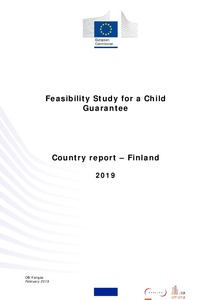Feasibility Study for a Child Guarantee: Country report – Finland
Olli Kangas
https://urn.fi/URN:NBN:fi-fe2021042826514
Tiivistelmä
In
regard to social security in general, and family benefits in particular,
Finland is among the big spenders. Spending on social security makes up 32
percent of the GDP, and 11.6 percent of all social spending and 3.7 percent of
the GDP are targeted at families and children. These investments are mirrored
in Finland's low levels of income poverty and social exclusion among families
with children. Finland and the other Nordic countries belong to the cluster of
nations with a very low share of deprived children. The same is true for the
other target groups (TG) and all the policy areas. In sum, according to
comparative EU statistics there are no major problems in Finland. Only a very
small fraction of children in the target groups have problems in the policy
areas in focus of the study. However, more nuanced analyses, and expert
interviews in particular, paint a much darker picture of several policy areas.
Immigrant
families do have more problems with regard to overburdened housing costs than
other families. Whereas physical healthcare does not seem to be a problem,
there are problems with regard to access to mental healthcare. This is a
serious problem for all the other TGs as well.
Finland
has focused on providing social and educational services to support the welfare
of the disabled children and their families. Disabled children have the right
to go to the school that is closest to their home. Services should be free of
charge, and municipality of residence is responsible for organising these
services. Too much depends on the municipality where the child happens to live.
If the necessary services are not available at all, or if they are
insufficient, children with disabilities can easily fall behind in their
education. Children living in institutions include a number of different groups
in Finland: disabled, children taken into custody care, other children placed
outside of their homes and refugee children. The biggest group of children
living in institutions comprises of those children that are placed outside
their homes (about 9,000 children). With regard to disabled children, there is
a tendency away from institutional care. By now, less than 200 children with
developmental disabilities are residing in institutional care facilities. Another
group of children living in institutions are refugees who are placed in
reception centres (young refugees in reception homes and teenage refugees in group
homes) while their asylum application is being processed.
Recommendations:
·
Finland
should improve access to health care in general and mental health care in
particular.
·
Processing
asylum applications must be much faster.
·
More
effective measures should be taken to ensure that all children receive enough
support for studying at school, and secure the accessibility of basic education
and upper secondary and higher education after basic education in spite of
disabilities or other personal characteristics.
·
Finland
should introduce budget tracking from the perspective of children's rights and
welfare, with a view to monitoring the budget allocations for children.
·
Resources
for supporting children with specific needs should be fortified in the
educational system.
·
Support
for children leaving institutions or foster care should be fortified.
·
The
coordination of social, health and educational services must be improved.
Kokoelmat
- Rinnakkaistallenteet [19207]
